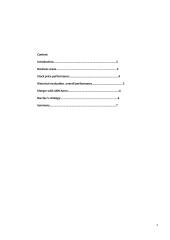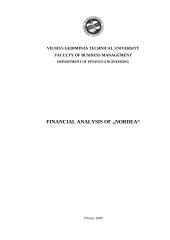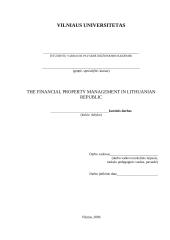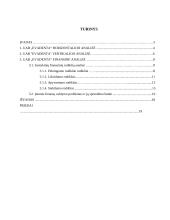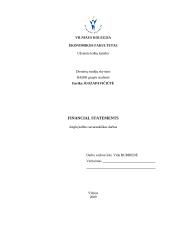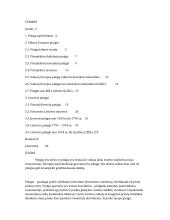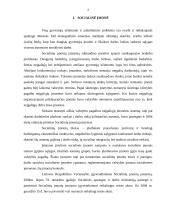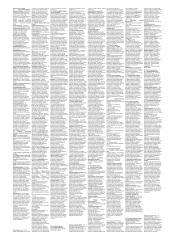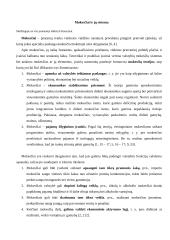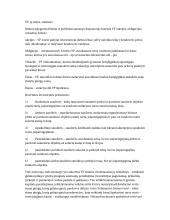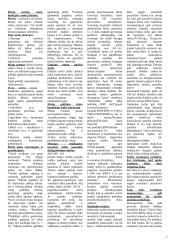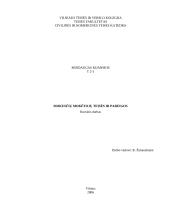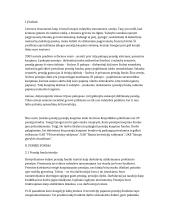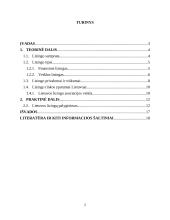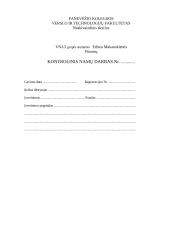Kursiniai darbai
Financial analysis: dental clinic UAB "Evadent"
TABLE OF CONTENTS TABLE OF CONTENTS 2 INTRODUCTION 3 1. CORPORATE FINANCE CONCEPT ANALYSIS 4 2. FINANCIAL REPORTS 4 3. FINANCIAL ANALYSIS TYPES 5 4. “EVADENT" HORIZONTAL ANALYSIS 7 5. “EVADENT" VERTICAL ANALYSIS 9 6. “EVADENT" FINANCIAL ANALYSIS 11 6.1. Relative financial performance analysis 12 6.1.1. Profitability ratios 12 6.1.2. Liquidity indicators 14 6.1.3. Performance indicators 16 6.1.4. Stability indicators 18 6.2. Company's financial management problems and their solutions 20 CONCLUSIONS 22 LITERATURE 23 APENDIX A. “EVADENT” BALANCE SHEET (2007-2009) 24 APENDIX B. “EVADENT” profit (loss) report (2007-2009) 26 APENDIX C. FINANCIAL RELATIVE (COMPARATIVE) INDICATORS 28 INTRODUCTION Enterprises activity is highly dynamic, risk-taking in the market economy that is why analyzing it must be borne in mind and analysis must be carried out on time. Based on the analysis of financial data base, you can do the business efficiency, profitability and viability of describing the findings and support them to develop and introduce new projects. Only a timely and objective financial analysis gives the possibility of different levels of managers to develop its alternative business models and a more rational management decisions for a certain period of time. Only few companies in Lithuania perform financial analysis and forecasting, or do so formally, there is little emphasis on the importance of analytical information in decision-making. Financial indicators for the analysis and prediction of the theoretical aspects should be applied to specific business activities, because they help determine the financial aspects of the business, assess the current situation and future prospects. Financial analysis provides useful information in view of the future borrowing, distribution of profits, unused reserves, improve its financial condition. Information about the company's financial condition changes is useful for investments, financing and business activity during the reporting period. All this is important for modern business. The aim of this paper - according to 2007-2009 balance sheet and profit (loss) report to analyze dental clinic UAB “EVADENT” financial condition. The tasks: • Provide a firm, horizontal and vertical analysis. • Calculate the company's liquidity, stability, profitability and turnover ratios. • Identify key enterprise financial management issues and theoretically justify the possible ways of solving problems. • To draw conclusions about the financial condition and performance improvement. 1. CORPORATE FINANCE CONCEPT ANALYSIS Financial performance analysis concept of different literary sources is very diverse. Often these same processes are described by different authors in different terms. In one sources of financial performance analysis is described as "comprehensive and objective financial situation of companies, operating results and cash flow analysis, to help companies achieve the objectives of management". Other distinguishes between two terms: the financial analysis - as the whole of the economic analysis and financial analysis - an analysis of financial performance. These terms - financial performance, technical and financial analysis describes essentially the same process and differences between them are minor, affecting a greater depth of analysis. Corporate finance is an area of finance dealing with financial decisions business enterprises make and the tools and analysis used to make these decisions. The primary goal of corporate finance is to maximize corporate value while managing the firm's financial risks. Although it is in principle different from managerial finance which studies the financial decisions of all firms, rather than corporations alone, the main concepts in the study of corporate finance are applicable to the financial problems of all kinds of firms. The discipline can be divided into long-term and short-term decisions and techniques. Capital investment decisions are long-term choices about which projects receive investment, whether to finance that investment with equity or debt, and when or whether to pay dividends to shareholders. On the other hand, the short term decisions can be grouped under the heading "Working capital management". This subject deals with the short-term balance of current assets and current liabilities; the focus here is on managing cash, inventories, and short-term borrowing and lending (such as the terms on credit extended to customers). The terms corporate finance and corporate financier are also associated with investment banking. The typical role of an investment bank is to evaluate the company's financial needs and raise the appropriate type of capital that best fits those needs. 2. FINANCIAL REPORTS Financial statements must also be a number of different definitions. One of them, "Financial Statements - an accounting firm economic data on a periodic summary of financial activities and structured in a certain way. It also stressed that the financial statements of a certain time period or the company's financial position reflected. This is one of its shortcomings and a factor to be considered, since the firm's activities are continuous and the very next day the company's results will be other than the financial statement date. The financial statements do not reflect the company's financial condition during the evolution of reporting period, only the difference between the beginning and end of the period, or only the end point. To avoid this problem should be analyzed each day of the financial statements, and then be faced with the problem of information overload. Frequently seen quarterly - 3-month financial reporting period is considered ideal. In various countries, the financial statements are different. Lithuania financial statements in accordance with Lithuanian Business Accounting Standards are as follows: • balance; • profit (and loss) statement; • cash flow statement; • profit-sharing report; • explanatory letter. These financial statements consist of the items some of which are broken down into even smaller elements. 3. FINANCIAL ANALYSIS TYPES Almost all the literature identifies three major types of financial analysis, using it to play: 1. Horizontal analysis; 2. The vertical analysis; 3. Relative Analysis. Horizontal Analysis: Displays two or more periods of financial reporting indices or their dynamics. Changes in the variables are calculated in absolute terms and as a percentage, how much has changed in comparison with the measured rate of the base period rate. Vertical Analysis: Displays the financial statements of each variable relative size of the total base rate. Which part of it. The indicator is expressed as a percentage of the base rate is always 100%. Brief analysis of the horizontal run changes in variables, and analysis of the vertical parts. As shown in the table below. The following table shows the analysis and the origin of species names. Since reporting the results of the different characteristics of vertically and horizontally in different periods of record. These analytical methods are among the most simple, direct analysis of their company's financial reports. Relative Analysis: Displays the logical relation between two variables reporting relationship. This analysis method is very common among all businesses with one another. The calculation relative number of indicators, which even the name is not united. There is no uniformity of their grouping, the various authors in accordance with the factors they consider important to classify the various groups: 1. Profitability; 2. Short-term and long-term solvency; 3. Performance; 4. Capital Market. 4. “EVADENT" HORIZONTAL ANALYSIS Horizontal analysis - two or more years of financial statements of comparison. The analysis helps identify the year index. The analysis determined the horizontal deviation from the basic rate. Table 1. “EVADENT” horizontal balance analysis (2007 - 2009) The horizontal balance analysis of 2007 - 2009, carried out by comparing “EVADENT" three years financial data helps to determine the company's assets and its funding sources, changes in absolute and percentage terms during the period. From a horizontal balance analysis of the activists, we can say that the company's assets in 2009 compared to 2008 increased by 35 449 Lt1 or 39 percent. Compared to the year 2009 to 2007 all the company's assets increased by 50 857 Lt or 67 percent. The analysis of individual items, we can see that the fixed assets compared to the year 2009 to 2008 increased by 835 Lt. or 1 percent. and the year 2009 compared to 2007 - increased by 11 216 Lt or 19 percent. Short-term assets in 2009 compared to 2008 grew by 34 614 Lt. And the year 2009 compared to 2007 - has also increased 39 641 Lt. During the analyzing period - stocks are increasing all the time, compared to 2009 2007 up to 20 000. During this period cash had tendency to grow also. Prepayments is also increasing. The other short-term asset - customers in arrears and other receivables are varied. After accomplishment of the horizontal balance analysis of passive Table 1 shows that compared to the year 2009 to 2007, the owners of the property and liabilities increased by 67 percent. or it would be 50 857 Lt. Year 2009 compared to 2007 equity decreased 9 690Lt and short-term debt has risen 4.03 percent. or 45 547 Lt Short-term debt increase was due to the company debt to suppliers 14 159 Lt, and taxes, wages and related liabilities – 7 815 Lt. Table 2. “EVADENT" horizontal profit (loss) analysis (2007 - 2009) No. Property Absolute change, Lt Growth rate, % 2009 with 2007 2009 with 2008 2009 with 2007 2009 with 2008 I. Sales revenue 324256 2501.90 II. Cost of sales 231299 2928.31 III. Gross profit (loss) 92957 1846.66 IV. Operating expenses 75483 58832 841.56 319.28 V. Operating profit (loss) 22796 34125 -123.95 -58.66 VI. Other activities VII. Financial and investment activity -195 164.57 VIII. Ordinary profit (loss) 22299 33930 -119.07 -55.57 IX. Gains X. Disposals XI. Profit (loss) before taxation 22299 33930 -119.07 -55.57 XII. Income tax XIII. Net income (loss) 22299 33930 -119.07 -55.57 Table 2 of this work shows companies' financial results in 2009 compared with 2008 where the increase in sales revenue is 324 256 Lt, an increase in output of goods and works cost 231 299 Lt what led to an increase in overall profits 92 957 Lt. 5. “EVADENT" VERTICAL ANALYSIS Vertical analysis - the financial statements rate compared with the base (general) rate of that report, and any size is expressed as a percentage of the base rate. Table 3. “EVADENT"general vertical balance analysis (2007 - 2009) No. Property Year 2007 2008 2009 A. Fixed asset 78.56 76.68 55.90 I. INTANGIBLE ASSETS II. TANGIBLE ASSETS 78.56 76.68 55.90 II.1. Vehicle 0.00 0.00 0.00 II.2. Other equipment, tools and equipment -33347.49 76.68 32.75 II.3. Other tangible assets 0.00 0.00 23.16 B. Current assets 21.44 23.32 44.10 I The stock, prepayments and contracts in progress 7.46 18.77 24.75 I.1. Reserves 6.27 15.77 1.2. Prepayments 7.46 12.50 8.98 II WITHIN ONE YEAR RECEIVABLES 0.00 0.00 1.20 II.1 customers in arrears 0.00 0.00 1.20 II.2 Other receivables 0.00 0.00 0.00 III. OTHER CURRENT ASSETS 0.00 0.00 0.00 IV. CASH AND CASH EQUIVALENTS 13.98 4.55 18.15 TOTAL ASSETS 100 100 100 C. Own Capital -0.24 -24.06 -7.78 I. CAPITAL 13.16 10.94 7.88 II Revaluation reserve II (RESULTS) III. RESERVES 0.00 0.00 0.00 IV. Retained earnings (LOSS) -13.40 -35.00 -15.66 D. The grant and subsidy E. Payables and liabilities 100.24 124.06 107.78 I AFTER ONE YEAR PAYABLE AND LONG-TERM LIABILITIES 98.71 98.48 70.96 II WITHIN ONE YEAR OF THE AMOUNT AND SHORT-TERM LIABILITIES 1.53 25.58 36.82 II.1. Debt to suppliers 0.92 9.26 11.71 II.2. Payments received in advance 0.00 0.00 6.62 II.3. Fees, salaries and social insurance 0.45 5.87 6.43 II.4. Other accounts payable and other liabilities 0.16 10.45 12.06 EQUITY AND LIABILITIES TOTAL 100 100 100 After the firm's balance activists general vertical analysis balance when the base is asset (Table 3), we can say that in 2007 the current assets amounted to 21.44 percent. And long-term asset 78.56 percent. The analysis for each year separately, we see that the fixed assets dropped each year and in 2009 was 55.90 percent. And short-term upward trend and accounted for 44.10 percent of total company assets. During analyzing period there was not major difference between long and short-term assets as the company's new fixed assets acquired or disposed of or written off. Indicators have changed only the tangible assets depreciation and reserves. Table 4. “EVADENT" Vertical income (loss) Report (in percentages) After making income (loss) reports vertical analysis (Table 4), we can say that sales of goods and services comprise the largest part of cost of sales income. This is from 60.58 percent in 2008 to 70.90 percent in 2009, as can be seen next to a negligible percentage. Bigger change can be seen in expenses which decreased from 198.74 percent in 2008 to 26.36 percent in 2009 of sales income. This affected the net profit in 2009 and 2008 loss, which varied from 3.59 percent sales revenue by minus 161.56 percent. This shows that with increasing operating costs each year, corporate profit was declining also. 6. “EVADENT" FINANCIAL ANALYSIS Financial activities and results of the analysis is a complex process. Depending on the individual authors for purpose and understanding, it is classified into certain types according to various attributes. But this analysis will be limited to one species - the relative analysis, known as the analysis of financial ratios. These coefficients express the financial statements and other information data exchanges. The analytical results expressed in the amounts, the ratio (or percentage of the coefficients). It should be noted that the relative financial indicators can be applied to the projected financial status of the company's assessment. In practice, the calculated relative number of different financial ratios. In this analysis, calculation of profitability, liquidity, financial stability and turnover rates. 6.1. Relative financial performance analysis The owners are very interested in their current investments and long-term profitability, dividends. These objectives are best meeting the group of indicators - profitability and market performance, income distribution analysis. Creditors control of the company's liquidity, and others indicators. 6.1.1. Profitability ratios Profitability ratios summarize and synthesize the best achievements of the company (Table 5). Table 5. Profitability ratios Formula 2008 2009 Gross sales yield (%) GSY=(GP/S)*100 39.42% 29.10% Net sales yield (%) NSY=(NP/S)*100 -161.56% 3.59% Operating yield (%) OY=(OP/S)*100 -159.32% 3.74% Property yield (%) PY=(NP/(LA+SA))*100 -23.87% 9.56% Equity capital yield (%) CY=(NP/EC)*100 99.19% -122.81% GP - the gross profit. S - sales. NP - net profit. OP- operating profit. LA- long-term assets. SA- short-term assets. EC - equity capital. One of the most important indicators of profitability is the gross profit rate that shows how much profit has been the sale to a cash unit. The higher gross profit rate, the firm's activities more efficient. The company is stable, if the gross profit rate "jumps" at the boundary of 5-15 per cent. Because EVADENT did not start activities in 2007, there were not any sales of service and any profit. In 2008-2009 the rate went from 39.42% to 29.10% (Figure 1). Fugure 1. “EVADENT” profitability ratios (2008-2009) The net rate of yield (or net profit margin) shows the full analysis of the profitability of the business end and how much profit has been determined for each unit of net sales revenue. Specific company profitability will be significant only after seeing him in comparison with similar companies operating in the same sector profitability ratio. Isolation rate does not provide any information because of the implicit level. When compared with the same industry average, it will be higher, which means that the company is working better than the competition. Since 2008 company occurred the loss, the figure was negative. 2009 the company earned a net profit, and service sales yield were 3.59%. Calculated profitability ratios of “EVADENT” assets and equity capital refers to the available resources in the performance. Figure 2. “EVADENT” property and equity capital profitability ratios (2008-2009). Figure 2 shows a very uneven situation. Since 2008 was incurred losses and negative equity, and net profit devided with equity capital came out positive. But when viewed from this perspective that these two values were both negative, the ratio is actually nothing, because those years have been very detrimental. When in 2009 receiving net profits and equity were also negative (although slightly less negative), equity yield rate was also negative. This negative figure is certainly a problem as the negative equity value. Asset profitability indicator of how much net profit accrue to one asset to a cash unit. It allows the assessment of the assets performance. The higher the index, the more efficient utilization of assets. Property yield is calculated as a percentage NP / (LA + SA) * 100, where NP - the net profit, LA- long-term assets, SA - short-term assets. Since 2008 was a loss, and this figure was negative. This means that the available assets have brought loss and still not have been profitable. Meanwhile, in 2009 company earned a net profit, so the Property yield was 9.56%. It can be said that the company began to use property much more profitable. Good to calculate separately the long-term and short-term assets profitability (Table 6). Table 6. Long-term and short-term assets profitability. Formula 2008 2009 Long-term assets profitability (%) LAP=(NP/LA)*100 -31.12% 17.09% Short-term profitability (%) SAP=(NP/SA)*100 -102.32% 21.67% Of the estimated indicators we can see that over the years the situation has changed dramatically long-term and short-term assets earned a net profit when in 2008 company had losses, and therefore the profitability indicators were negative. Profitability ratios provide interesting and useful information on companies, but the assessment of the stability and reliability necessary for broader financial analysis. The sole indicator of profitability assessment can provide the most benefit for short-term but not long-term investors. Thus, a profitable company - not necessarily stable, and in contrast, the loss does not mean defeat. 6.1.2. Liquidity indicators Before making a decision about the company, concerned about not only how much the company earns a profit. It is important that the company can meet its obligations to pay its debts, so run, not only profitability, but also a world other financial solvency, liquidity, debt coverage ratio. Low-yield, or even an ailing company could also be attractive if the other financial indicators testify to its ability to timely meet its liabilities. At the end of run solvency (liquidity) indicator, which compares the property with all obligations. Usually regarded as the company is solvent, if the property shall bear the obligations. The solvency rate higher in the lower level of financial risk, bankruptcy less likely to have greater access to borrow money. Table 7. Solvency ratios Formula 2007 2008 2009 Gross short-term liquidity ratio GSLR=SA/SL 14.05 0.91 1.20 Critical liquidity ratio CLR=(SA-ST)/SL 9.16 0.18 0.53 Absolute short-term solvency ratios ASSR=C/SL 9.16 0.18 0.49 Net working capital ratio of short-term assets (SA-SL)/SA 0.93 -0.10 0.16 ST - stock. C - cash. SL- Short-term liabilities. When calculating the liquidity ratio, 2007 is taken because the company already had current assets and current liabilities (Figure 3). Figure 3. “EVADENT” short-term solvency ratios dynamics (2007-2009) General liquidity ratio indicates whether a company has sufficient current assets to cover current liabilities. Low levels of this index (
Šį darbą sudaro 6105 žodžiai, tikrai rasi tai, ko ieškai!
★ Klientai rekomenduoja
Šį rašto darbą rekomenduoja mūsų klientai. Ką tai reiškia?
Mūsų svetainėje pateikiama dešimtys tūkstančių skirtingų rašto darbų, kuriuos įkėlė daugybė moksleivių ir studentų su skirtingais gabumais. Būtent šis rašto darbas yra patikrintas specialistų ir rekomenduojamas kitų klientų, kurie po atsisiuntimo įvertino šį mokslo darbą teigiamai. Todėl galite būti tikri, kad šis pasirinkimas geriausias!
Norint atsisiųsti šį darbą spausk ☞ Peržiūrėti darbą mygtuką!
- Finansų kursinis darbas
- 28 psl., (6105 ž.)
- Word failas 484 KB
- Lygis: Universitetinis
Mūsų mokslo darbų bazėje yra daugybė įvairių mokslo darbų, todėl tikrai atrasi sau tinkamą!
Panašūs darbai
Kiti darbai
Privalumai
Atsisiuntei rašto darbą ir neradai jame reikalingos informacijos? Pakeisime jį kitu nemokamai.
Pirkdamas daugiau nei vieną darbą, nuo sekančių darbų gausi 25% nuolaidą.
Išsirink norimus rašto darbus ir gauk juos akimirksniu po sėkmingo apmokėjimo!
Atsiliepimai



























